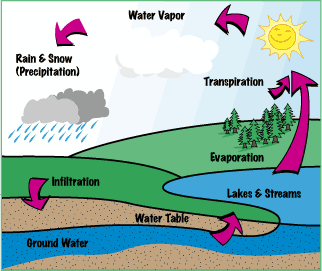

A conventional septic system consists of a septic tank, a distribution box and a drainfield, all connected by non-perforated and perforated pipes, called conveyance lines.
Your septic system treats your household wastewater by temporarily holding it in the septic tank where heavy solids and lighter scum are allowed to separate from the wastewater. This separation process is known as pretreatment. The organic solids stored in the tank are decomposed by bacteria and later removed, along with nonbiodegradable materials, by a professional septic tank pumper.
After partially treated wastewater leaves the tank, it flows into a distribution box, which separates this flow evenly into a network of drainfield trenches. Drainage holes at the bottom of each line allow the wastewater to drain into gravel filled trenches for temporary storage. This effluent then slowly seeps into the subsurface soil where it is further treated and purified by natural bacteria in the soil environment. A properly functioning septic system does not pollute the groundwater.


Onsite Wastewater Treatment Systems (OWTS) can be very simple or quite complex.
The conventional systems more commonly known as Standard Systems, consist of a septic tank and gravity fed drainfield. These systems are typically found in areas where parcel sizes are larger and soils are good for natural treatment.
The septic tank serves as a solids collection and separation device. A properly sized tank has the ability through detention time to slowly breakdown the organic materials through a process known as anaerobic waste treatment. Adequate tank sizing allows ample time for lighter material such as soaps, oils, greases and synthetic fibers to rise to the top of the tank and form a scum layer. The heavier materials such as dirt, inorganics and decomposed bacteria fall to the bottom and form the sludge layer. A clear zone is created in the middle of the tank. An outlet baffle or effluent filter allows the gravity flow to be directed from the clear zone as raw wastes enter the tank. A good functioning septic tank will remove between 25% to 40% of the wastewater constituents. When solids build up in the tank, capacity is lost, as is detention time, preventing proper separation and treatment. This is one of the leading causes of drainfield failure.
In a properly sited and designed drainfield lives the wonder of nature. Healthy soil contains millions of hungry microbes in just one cubic inch. When the soil has enough time to slowly filter the wastewater, these microbes go to town and purify the wastewater. In some areas however, if the water moves too fast to groundwater, pollution will occur. This is where Alternative Systems, while a bit more complex, can save the day


Over 25% of households in the United States rely on onsite wastewater disposal, and 33% of all new construction is employing it. Many rural businesses, such as motels, restaurants, service stations and rest stops depend on it. Onsite wastewater disposal has been the primary method worldwide throughout time. As the world population grows, we now recognize the need to treat wastewater before disposal to ensure safety of human health and the environment.


Locating a OWTS can be a tricky thing if proper documentation is not available. Years of out of sight, out of mind can result in a true task, especially if you don't have the right kind of equipment. A good Accredited Inspector or Qualified Service Provider (QSP) will have a number of tools to assist in system location. Soil Probes and Electronic Locating Devices are the most common.
The first clue in locating the septic tank is to identify where the main sewer line exits the home. From here the tank will typically be located 5 to 10 feet from the building. There are a couple of different types of soil probes that might be used. A push probe works great, providing the soil isn't too hard or the tank is not too deep. A slide probe can do well in harder soils but can only go about 4 or 5 feet down.
In the event the tank is too deep, or there is no clue where it is located, an electronic locating device is the key. A small transmitter is flushed down the toilet, or placed into a cleanout (the transmitter is attached to a string or fishing line). A receiving unit is then used to track the transmitter to the final destination. Sometimes the transmitter can get hung up on damaged pipes, root or debris blockage, but at least you then know where to start in terms of corrective action. Either way, then the digging begins! The best strategy is to install water tight, air tight access risers. Remove a few bolts, and your in. Septic Guy likes access risers!
Much of the same methods apply to locating final treatment and dispersal. Soil probes can often find drain rock below the ground surface, and electronic locators used with a push cable can be introduced into the tank outlet fitting or the distribution box to find drainlines. Newer systems include trench monitoring wells at the end of drainlines for checking liquid levels in or near the drainfield. This makes things much easier.
A good Accredited Inspector or Qualified Service Provider will be able to prepare an accurate plot plan for ease of future locating.


Maintenance is the key to OWTS long term performance. So what are the maintenance requirements of your system? This will no doubt vary, depending on the type of system you have or are considering. Alternative Systems have more maintenance needs than Standard Gravity Systems. Our Treatment Train section will provide maintenance details on various Alternative Systems.
Before we talk about the maintenance of Standard Gravity Systems, let's first talk about the first component of any OWTS, the source, you and your home. Your family's use habits and the condition of the plumbing will make all the difference in the world on the maintenance needs of your system. What and how much goes down the drain can result in years difference in tank pumping frequency. Check out the Septic School, What's My Role program, for a better understanding of proper care and use.
Ok, Standard Gravity System maintenance, Septic Guy recommends routine inspections rather than routine pumping. Why? Because even the simplest of systems rely on a biological process. Disrupting the process unnecessarily just slows it down. In addition, there is the potential to send unwanted solids into the dispersal area if a good job is not done cleaning the tank.
Routine Inspections every year or two can keep an eye on solids build up and help identify any adverse conditions before they impact the system. It's kind of like changing the oil in your car before the funny noises start. Funny noises, just like foul odors, can be very expensive. A lot can be determined by a simple tank inspection. A good Accredited Inspector or Qualified Service Provider will look for signs of tank deterioration, and/or plumbing leaks. They can also make suggestions to help the system in the event someone in the family might need extended medical treatment. This is one of the worst things for your OWTS, and lets face it, the septic system would be the last thing on your mind in this case.
Proper care and use will prolong the need for pumping and cost less in the long run than routine inspections. The other consideration is less Residual Solids or Septage to dispose of reducing the impact on the environment. Ecology and Economy, a truly sustainable concept.


Always call a pro! Property transfer inspections, Routine Inspections, Building Permit processing, Operation Maintenance & Monitoring, Minor repairs and/or System design, always call a credentialed professional. A credentialed professional has the training, knowledge, and understanding required to safely and effectively care for your system. Professional care helps protect your valuable investment and your family.
Property Transfer Inspection: If the property you are considering purchasing has an OWTS, it is a wise move to have it inspected. New systems can cost tens of thousands of dollars. An Accredited Inspector or Qualified Service Provider can't tell you how long a system will last, but they should be able to give you a good idea of it's current operational condition.
Routine inspection: Having a routine inspection done by an Accredited Inspector is one of your best investments. If your system is properly set up, a quick annual or biannual inspection can be done in pretty short order. Inspecting the tank integrity, and measuring solids can usually be done in less than an hour. This practice will allow you to monitor your family's use habits and impacts. It can also save you hundreds of dollars in septic tank pumping costs by only pumping when necessary. Your Accredited Inspector or Qualified Service Provider will inspect and clean your effluent filter thus preventing drainage slowdowns or backups into your home. Some folks choose to just pump every year or two, that's OK too. But remember, this is a biological system and each time it is pumped, it needs to reestablish itself.
Building Permit Inspections: Some areas require a septic inspection prior to issuing building permits. These local agencies will usually publish a list of individuals who qualify under their guidelines.
Operation Maintenance & Monitoring: You may have an Advanced Treatment Technology system that requires regular Operation, Maintenance and Monitoring. A Qualified Service Provider is essential in this case.
Minor Repairs: Some people may have the unfortunate experience of inheriting a system that has been damaged or neglected. Many repairs can be done under permit by a licensed installing contractor.
System Design: If you are building a new system or replacing one that just can't be revived, a qualified professional such as a Soil Scientist, Registered Environmental Health Specialist, Registered Geologist or a Registered Civil Engineer are typically all qualified to help you. They can take you step by step through the process of repairing or replacing your system.



The big deal is, that the concentration of man-made toxins and pollutants are increasing at an alarming rate in our fresh water supply. Water is a finite resource, it does not enter nor leave our atmosphere. The hydrologic cycle is nature's way of purifying our water. Water evaporates from our streams, lakes and oceans, and transpires from the precious vegetation on the planet. It then condenses into clouds, where it falls back to earth in the form of rain and snow. The water then percolates into the ground where natural biological filtration purifies it as it returns to the water table to start the cycle all over again. Our forests are diminishing, and our bare ground is being covered by development, reducing the natural systems that purify our water and air. In the mean time, more toxic compounds are being developed every day for the sake of human convenience.
It is extremely important we recognize how our use and disposal habits impact the environment.







